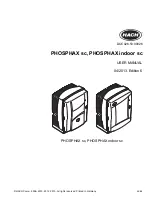
Operating Instructions
VA-1A Installed in the Alternator Lead
7
With the Mode Switch in the “Amps” position the VA-1A will display the electrical system load on
the aircraft plus the battery charging current. Since the engine is on, all of the current is being
supplied by the alternator. The VA-1A will show a charging condition (the “Discharge” light will
be off) and display an accurate reading of the total current drain from the alternator. In this
mode of operation any piece of electrical equipment can be checked for proper operation during
flight by performing the following steps:
A. Note the amps reading on the VA unit.
B. Turn off the piece of electrical equipment you wish to check.
C. If this piece of electrical equipment is working properly, you will see a decrease in load
current that corresponds to the current that piece of equipment requires. Compare this
current with the current you measured for that same piece of equipment at an earlier date.
Using this method with the digital display of the VA-1A, many important aircraft functions
(strobes, retracts, radios, transponder, ADFs, DMEs, pitot heat, etc.) can be checked from the
pilot’s seat. It would be worthwhile to write down the load current for the entire system and for
each piece of equipment. This would give you something to compare to when you wish to check for
proper operation at a later date. You may also check the entire electrical system with one check
by turning all the electrical equipment on and comparing this reading with your normal reading
taken at an earlier date. If an improper reading is noted, the VA-1A may then be used to diagnose
which piece of equipment has malfunctioned by checking each piece of equipment separately.
With the mode selector switch in the “Volts” position the VA-1A will display the bus voltage to .1 volts.
With the engine running the alternator is capable of raising the bus voltage to a dangerously high level. It is
the voltage regulator's job to limit the bus voltage between 13.5 and 14.8 volts (double these levels for a
24-volt system). Look for this level on the VA-1A. A low voltage reading will cause the battery to
charge very slowly. A high reading can damage the battery and most of your electrical equip-
ment. If the aircraft bus voltage goes to a dangerously high level (15.3 volts or higher) a bright
red “High Volts” light on the VA-1A will warn you of this condition. If this happens turn the field
to the alternator off to eliminate the over voltage condition.
Another common electrical problem is a discharging condition. If this condition goes unnoticed
(which it normally does) you will end up with a dead battery in flight rendering all of your electri-
cal equipment useless. To help you avoid this situation the VA-1A has a “Discharge” Warning
Light which acts as an early warning to alert you as soon as the battery goes into a discharging
condition. If this situation occurs, turn off any unnecessary electrical equipment. The lower you
can get the discharging current, the longer the battery will last. With the VA-1A installed in the
alternator lead, discharging current cannot be monitored.
The VA-1A will display trend information when your battery is in a discharging condition. As you
watch the battery discharging .1 volts at a time, it becomes relatively easy to judge the remaining
time you have before the battery reaches a seriously low condition. As the battery voltage ap-
proaches 11 volts (22 volts for a 24-volt system), the aircraft’s electrical equipment will start to
malfunction. The exact voltage at which each piece of equipment will start to malfunction depends
on the design of that equipment. The VA-1A will work accurately from 40 to 7 volts--far below
where most electrical equipment starts to fail.












































